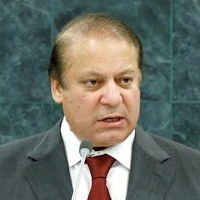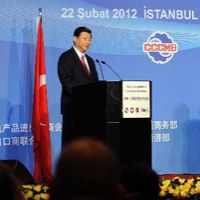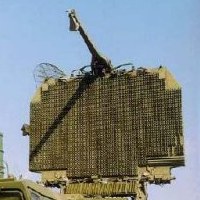![]()
Tue, Oct 4, 2011 | Middle East Forum | American Spectator | by Aymenn Jawad Al-Tamimi
Pakistan and China: Strengthening Ties
As U.S. military operations in Afghanistan drag on, a strengthening relationship between Pakistan and China has emerged as tensions between the former and the United States continue to grow.
Of particular interest are the trilateral meeting just held between Chinese, Saudi and Pakistani intelligence officials in Islamabad and a two-day visit to Pakistan by the Chinese Deputy Prime Minister Meng Jianzhou. Both of these developments come in the midst of growing concern among U.S. officials about the problem of ISI (Pakistani intelligence) support for a militant group known as the Haqqani Network, which has bases in Pakistan and conducts operations against American and Indian targets in Afghanistan.
For example, the Haqqani Network is widely suspected of being behind the bombing of the Indian embassy in Kabul in 2008, and more recently cell phone trails have established that members of the organization were in contact with Pakistani intelligence before and during the assault on the U.S. embassy in the Afghan capital this month.
Pakistan’s response, however, has been to deny any links between the ISI and Haqqani Network, while accusing the United States of creating the group in the first place. In fact, Jalaluddin Haqqani, the godfather of the organization, was already a devotee to jihadist ideology by the mid-1970s, aiming back then to overthrow the government of Mohammed Daoud Khan, who had seized power from King Zahir in 1973 and established an Afghan republic.
Thus, the militants behind the Haqqani Network (including some Chechen, Palestinian and Yemeni fellow fighters) were already active well before the Soviet invasion of Afghanistan and the subsequent joint CIA-ISI enterprise of providing support to various mujahideen warriors in their jihad against the Soviet occupation forces in the 1980s.
Although the leadership of the Pakistan Army is now firmly refusing to take any action against the Haqqani Network in the form of a military offensive in North Waziristan, Pakistan’s Interior Minister Rehman Malik has vowed to attack and pursue Muslim Uighur militants who operate in China’s western province of Xinjiang but take refuge and undergo training in Pakistan’s border areas with Afghanistan (often in cooperation with al-Qa’ida and other Islamist militant groups that have firm footholds in Pakistan). As Malik himself put it, “We will strike very hard against them [the Uighur militants]. Anybody who is the enemy of China is the enemy of Pakistan.”
Strengthening ties extend to the realm of arms deals, and now even entail the deployment of Chinese troops in Pakistani territory. For example, in May, China agreed to provide 50 new JF-17 Thunder multi-role fighter planes to the Pakistan Air Force (PAF) “immediately” (a deal had been signed earlier, but during the Pakistani Prime Minister Yousuf Gilani’s visit to China discussion was also raised over the possibility of further Chinese supplies to the PAF of J-20 Stealth and Xiaolong multi-purpose light fighter aircraft). It would appear that as Pakistan increases its military cooperation with China, the country is distancing itself from American military support and aid. Indeed, it is expected that the presence of U.S. military personnel in Pakistan will be halved.
As for the stationing of Chinese troops in Pakistan, it is estimated that there are currently around 11,000 soldiers of the People’s Liberation Army in Pakistan’s northern province of Gilgit-Baltistan and in Pakistani Kashmir, facilitating the opening of branches of Chinese banks and construction of concrete residential houses for these troops. This development should primarily be understood in light of the fact that engineers are working on a railroad that is intended to extend from the port of Gwadar in the southwestern province of Balochistan (a port that will be very important for future Chinese proximity to the Persian Gulf) all the way into western China.
Once Pakistan’s strengthening alliance with China in opposition to what is perceived as a U.S.-India axis is taken into account, the policies of the Pakistani military and intelligence towards the various Islamist militants based or operating in Pakistan become very easy to explain. The inconsistency of refusing to launch an offensive against the Haqqani Network while vowing to hunt down Uighur militants has already been noted. Beijing certainly has no problem with ISI backing of the Haqqani Network: so long as the group harms Indian influence and interests in Afghanistan, so much the better for China. China, after all, feels the need as an ever growing economic power to compete with India for Afghanistan’s vast mineral reserves, having already invested $3 billion in the vast Aynak copper mine.
Now we can also see why the ISI and Pakistan Army safeguard and protect the Taliban Shura and other Islamist militants based or operating in Balochistan (especially in and around the provincial capital of Quetta), for they serve as good proxies against the Baloch nationalist insurgency. The Baloch insurgency not only regards Pakistani rule and the presence of Punjabi settlers as an occupation but also is justifiably outraged at the fact that the indigenous population is largely deprived of income from Balochistan’s massive copper reserves, which are being developed and exploited by China and the Pakistani central government.
Pakistan’s desire to counter India applies to Punjab province as well, where a host of Islamist militant organizations (e.g. Lashkar-e-Taiba) enjoy the patronage of the ISI and the provincial government headed by Chief Minister Shahbaz Sharif.
These groups have often provided safe havens for militants returning from Afghanistan (as well as those in the border regions who have been given escape routes and early warnings by the Pakistani security forces during operations as part of a double game to win American financial support), allowing many Islamist militants to set up their own seminaries in south Punjab. The predictable result of all this has of course been the increasing destabilization of Punjab itself, giving rise to a phenomenon known as the “Punjabi Taliban” that has bombed Sufi shrines, inter alia.
The emerging picture is clearly one of a Sino-Pakistani partnership aligned against what is seen as a U.S.-India axis designed to limit Pakistan’s assertion of its interests in Afghanistan, Kashmir and parts of India on account of an expansionist policy known as “strategic depth,” which has always been espoused by the Pakistani military and intelligence and is rooted in Pakistan’s perception of its identity as an Islamic state. These developments could well lead to what some analysts have termed a “looming superpower clash” between the United States and China over Afghanistan and the wider region, triggered by Pakistan.
Aymenn Jawad Al-Tamimi is a student at Brasenose College, Oxford University, and an intern at the Middle East Forum.



 RSS
RSS











Pakistan and China: Strengthening Ties | Middle East News, Articles, Background, Opinion, Analysis http://t.co/3QQOU3Ug
Pakistan and China: Strengthening Ties | Middle East News, Articles, Background, Opinion, Analysis http://t.co/3QQOU3Ug